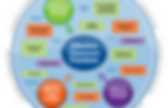

Tips & Tools to Improve Student Notetaking Skills. I am a scribbler and a note-taker.
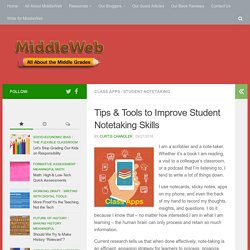
Whether it’s a book I am reading, a visit to a colleague’s classroom, or a podcast that I’m listening to, I tend to write a lot of things down. I use notecards, sticky notes, apps on my phone, and even the back of my hand to record my thoughts, insights, and questions. I do it because I know that – no matter how interested I am in what I am learning – the human brain can only process and retain so much information.
Current research tells us that when done effectively, note-taking is an efficient, engaging strategy for learners to process, organize, and transform information (Fryer, 2014; Hattie, 2012). But in the classroom, rarely do our students get excited about taking notes. The good news is that with a few adjustments we can help students transform the painful process of note-taking into a terrific tool for thinking. Note-taking: the first steps After a few failed attempts, I was frustrated, and so were they. Why Some Teachers May Question ‘New’ Education Trends.
Often frustration with the public education system is directed at teachers, even when they are following the standards and guidelines set out by the government.
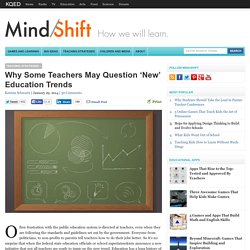
Everyone from politicians, to non-profits to parents tell teachers how to do their jobs better. So it’s no surprise that when the federal state education officials or school superintendents announce a new initiative that not all teachers are ready to jump on the new trend. Education has a long history of reform, each succeeded by another, and teachers have learned to pick and choose carefully where to put their energies. “There is such a gap between policy talk and what happens on the ground,” said Larry Cuban, professor emeritus of education at Stanford University and a former high school social studies teacher and district superintendent.
53 Ways to Check for Understanding. 5 Fantastic, Fast Formative Assessment Tools. I thought I could read my students' body language.
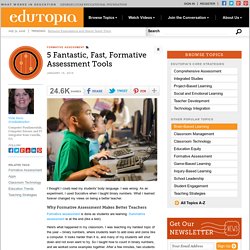
I was wrong. As an experiment, I used Socrative when I taught binary numbers. Before Reading or Watching Videos, Students Should Experiment First. The researchers drew on data gathered from students using the BrainExplorer, a tabletop tool that simulates how the human brain processes visual images.

By David Plotnikoff A new study from the Stanford Graduate School of Education flips upside down the notion that students learn best by first independently reading texts or watching online videos before coming to class to engage in hands-on projects. Studying a particular lesson, the Stanford researchers showed that when the order was reversed, students’ performances improved substantially. While the study has broad implications about how best to employ interactive learning technologies, it also focuses specifically on the teaching of neuroscience and underscores the effectiveness of a new interactive tabletop learning environment, called BrainExplorer, which was developed by Stanford GSE researchers to enhance neuroscience instruction.
Five Research-Driven Education Trends At Work in Classrooms. Helping Students Fail: A Framework. Helping Students Fail: A Framework by Terry Heick Ed note: This post is promoted by bettermarks, an adaptive math platform built around the idea of learning through mistakes.
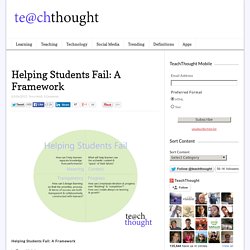
They are looking for feedback from classrooms teachers, and are offering a one-year, no strings trial of their platform here. As teachers, allowing students to see failure as a negative experience is one of the worst things we can do. What Keeps Students Motivated to Learn?
Educators have lots of ideas about how to improve education, to better reach learners and to give students the skills they’ll need in college and beyond the classroom.

But often those conversations remain between adults. The real test of any idea is in the classroom, though students are rarely asked about what they think about their education. 3 Strategies to Give Students Authentic Audience @lindayollis. Building authentic audience is an essential technique for 21st century teachers.

Linda Yollis, a 27 year elementary teacher shares with us how she uses social media in the classroom. Using their class blog and teacher’s social media connections, Linda’s students write for the world. Would You Know Deeper Learning If You Saw It? - Learning Deeply. This post is by Libby Woodfin, a former teacher and school counselor and the director of publications for Expeditionary Learning.
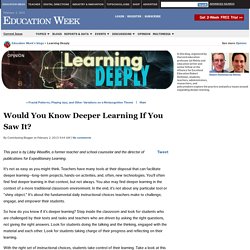
It's not as easy as you might think. Teachers have many tools at their disposal that can facilitate deeper learning--long-term projects, hands-on activities, and, often, new technologies. You'll often find find deeper learning in that context, but not always. Book - The Differentiated Classroom, 2nd Edition by Carol Ann Tomlinson. By Carol Ann Tomlinson Today more than ever, The Differentiated Classroom is a must-have staple for every teacher’s shelf and every school’s professional development collection.
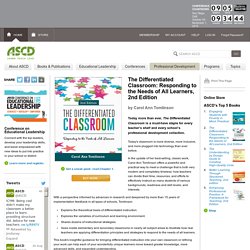
Today's classroom is more diverse, more inclusive, and more plugged into technology than ever before. In the update of her best-selling, classic work, Carol Ann Tomlinson offers a powerful and practical way to meet a challenge that is both very modern and completely timeless: how teachers can divide their time, resources, and efforts to effectively instruct so many students of various backgrounds, readiness and skill levels, and interests. With a perspective informed by advances in research and deepened by more than 15 years of implementation feedback in all types of schools, Tomlinson. The use of data: Getting the whole picture SmartBlogs. Education is a lot like baseball: They were both slow to embrace data as a tool for decision-making, but now accept it as an integral part of how they function.
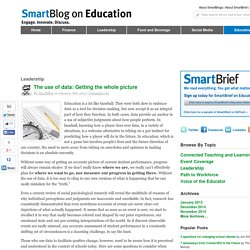
In both cases, data provide an anchor in a sea of subjective judgments about how people perform. In baseball, knowing how a player does over time, in a variety of situations, is a welcome alternative to relying on a gut instinct for predicting how a player will do in the future. In education, which is not a game but involves people’s lives and the future direction of our country, the need to move away from relying on anecdotes and opinions in making decisions is an absolute necessity. Without some way of getting an accurate picture of current student performance, progress will always remain elusive: If we don’t really know where we are, we really can’t effectively plan for where we want to go, nor measure our progress in getting there.
Fixing the US STEM problem—commentary. What Project-Based Learning Is — and What It Isn’t. Screenshot/High Tech High. Differentiation Doesn't Work. Commentary —Chris Whetzel for Education Week By James R. The Difference Between Praise and Feedback. By Anya Kamenetz Parenting these days is patrolled by the language police. What the Future of Learning Might Look Like. How ‘Deprogramming’ Kids From How to ‘Do School’ Could Improve Learning. iStock One day, Adam Holman decided he was fed up with trying to cram knowledge into the brains of the high school students he taught. They weren’t grasping the physics he was teaching at the level he knew they were capable of, so he decided to change up his teaching style. How Black Students Tend to Learn Science. Transforming a lecture into a more active experience is one possible way of fixing STEM's diversity dilemma. Jirka Matousek/Flickr Ryan Hynd wouldn't call it an epiphany but he doesn’t deny that the research program he joined the summer of his junior year at Georgia Tech shaped his career.
“It wasn't exactly a turning point, but it was like an awakening. Step by Step: Designing Personalized Learning Experiences For Students. Some Struggles Teachers Face Using Games in the Classroom. iStock. About UDL. What Kids Want Out of School. 13 Strategies to Improve Student Classroom Discussions. Samantha Cleaver Leo Tolstoy's The Two Brothers tells the story of two brothers who are offered the opportunity to find happiness. One chooses to go on a journey and finds happiness—as well as difficulties—along the way, while the other stays at home and leads a happy but uneventful life. When Jasmine Williams' fifth-grade students at Carter School of Excellence in Chicago read The Two Brothers, they discussed this question: Which brother made the better choice?
Williams' students sat in a circle, holding their books and graphic organizers filled with notes. "I believe the older brother made the best decision," said one student, "because in the text, the author said that he weighed all the negative possibilities and risks first. " Design Tips for Science Learning Spaces. Four Ways to Move from ‘School World’ to ‘Real World’ General Assembly. A veteran teacher turned coach shadows 2 students for 2 days – a sobering lesson learned. The following account comes from a veteran HS teacher who just became a Coach in her building. Because her experience is so vivid and sobering I have kept her identity anonymous.
But nothing she describes is any different than my own experience in sitting in HS classes for long periods of time. Why Inquiry Learning is Worth the Trouble. Defining Collaborative Teaching. 20 Collaborative Learning Tips And Strategies For Teachers. Why Marzano's Homework Research Is Flawed - Brilliant or Insane. How to (Once and For All) Correct Mistaken Beliefs. “Often mistaken, never in doubt.” Evolving How We Plan Learning Means Chloroforming The Unit. Student-centered-teaching.jpg (JPEG Image, 1000 × 750 pixels)
Teaching Is Establishing The Need To Know. How to Turn Your School Into a Maker Haven. Why Academic Teaching Doesn’t Help Kids Excel In Life. How Does the Brain Learn Best? Smart Studying Strategies. Kids Speak Out on Student Engagement. The Challenges and Realities of Inquiry-Based Learning. Ice Breaker Games for High School Students. English for Life. Six Ways To Motivate Students To Learn. Let’s stop trying to teach students critical thinking. What Kids Should Know About Their Own Brains.
12 Questions To Promote Self-Knowledge In Students. Five Ways to Bring Innovation Into the Classroom. Experimenting and Innovating: How to Find the Best Tools and Tactics. 10 Creative Ways to Introduce Yourself to Your Students. What Project-Based Learning Is — and What It Isn’t. Why Is It So Hard to Change How We Teach Math? The Power of Teacher Collaboration. The Science Behind Our Urge To Procrastinate. The U.S. Neglects Its Best Science Students. Five Research-Driven Education Trends At Work in Classrooms. How to Read Education Data Without Jumping to Conclusions - Jessica Lahey and Tim Lahey.
A School That Ditches All the Rules, But Not the Rigor. 10 Team-Building Games That Promote Collaborative Critical Thinking. 100 Words Every Expert Author Should Know. The Difference Between Praise and Feedback. Anyone Still Listening? Educators Consider Killing the Lecture. Before Reading or Watching Videos, Students Should Experiment First. Bloom’s revised Taxonomy with verbs! Breaking the Conflict Cycle at School. Awesome Chart for Teachers- Alternatives to Traditional Homework.
8 Essential Skills for New Teachers. 8 Ways to Build Positive School Culture Now. How to Reach Reluctant Learners - Education Week Teacher. And the most EXCITING SYLLABUS goes to… Why Inquiry Learning is Worth the Trouble. How Opening Up Classroom Doors Can Push Education Forward. Refuse To Be A Boring Teacher. For Students, the Importance of Doing Work That Matters.
Beyond Worksheets, A True Expression of Student Learning. The Drummer’s Secret: Math Meets Hip Hop. Do You have the Personality To Be an Inquiry-Based Teacher? MindSet: A Book written by Carol Dweck. Teaching a growth mindset creates motivation and productivity in the worlds of business, education, and sports. Teach for Understanding. Project Based Learning. Why Kids Need Schools to Change. 7 Big Hurdles In Education and Ideas For Solving Them. Flip Your PD for Extra Flexibility & Support. Are kids learning? How one of the best public high schools in Pennsylvania gets education right. Less lecturing, more doing: New approach for A.P. classes. Bigger Gains for Students Who Don’t Get Help Solving Problems. What Role Do Hunches Play in Professional Learning Communities? Five Research-Driven Education Trends At Work in Classrooms.
Steve Hargadon: Escaping the Education Matrix. 5 Tools to Help Students Learn How to Learn. Choice Equals Power: How to Motivate Students to Learn. Kids Want to Know: How Is Science Relevant? A Classroom Where No One Cheats - Jessica Lahey. . . . Top 10 Characteristics of Effective Vocabulary ... 3 Ways Connected Educators Can Help Transform Education. Welcome to Teaching That Makes Sense! 5 Learning Techniques Psychologists Say Kids Aren’t Getting. Design Thinking, Deconstructed. The family sending all ten of their home-schooled children to college by the age of 12. The Thoughtful Classroom: Professional Development, Differentiation, Learning Styles, Training, Silver, Thoughtful Education. K-12 Education & Learning Innovations with Proven Strategies that Work.